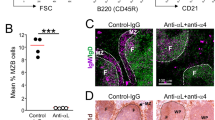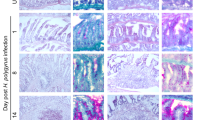Abstract
The immune system is central in the pathogenesis of scrapie and other transmissible spongiform encephalopathies (TSEs) or 'prion' diseases1. After infecting by peripheral (intraperitoneal or oral) routes, most TSE agents replicate in spleen and lymph nodes before neuroinvasion2. Characterization of the cells supporting replication in these tissues is essential to understanding early pathogenesis and may indicate potential targets for therapy, for example, in 'new variant' Creutzfeldt-Jakob disease. The host 'prion' protein (PrP) is required for TSE agent replication3,4 and accumulates in modified forms in infected tissues. Abnormal PrP is detected readily on follicular dendritic cells (FDCs) in lymphoid tissues of patients with 'new variant' Creutzfeldt-Jakob disease5, sheep with natural scrapie6 and mice experimentally infected with scrapie7. The normal protein is present on FDCs in uninfected mice7 and, at lower levels, on lymphocytes8. Studies using severe combined immunodeficiency (SCID) mice, with and without bone marrow (BM) grafts, have indicated involvement of FDCs and/or lymphocytes in scrapie pathogenesis9. To clarify the separate roles of FDCs and lymphocytes, we produced chimeric mice with a mismatch in PrP status between FDCs and other cells of the immune system, by grafting bone marrow from PrP-deficient knockout mice4 into PrP-expressing mice and vice versa. Using these chimeric models, we obtained strong evidence that FDCs themselves produce PrP and that replication of a mouse-passaged scrapie strain in spleen depends on PrP-expressing FDCs rather than on lymphocytes or other bone marrow-derived cells.
This is a preview of subscription content, access via your institution
Access options
Subscribe to this journal
Receive 12 print issues and online access
$209.00 per year
only $17.42 per issue
Buy this article
- Purchase on Springer Link
- Instant access to full article PDF
Prices may be subject to local taxes which are calculated during checkout




Similar content being viewed by others
References
Mabbott, N.A., Farquhar, C.F., Brown, K.L. & Bruce, M.E. Involvement of the immune system in TSE pathogenesis. Immunol. Today 19, 201–203 ( 1998).
Kimberlin, R.H. & Walker, C.A. Pathogenesis of mouse scrapie: dynamics of agent replication in spleen, spinal cord and brain after infection by different routes. J. Comp. Pathol. 89, 551–562 (1979).
Bueler, H. et al. Mice devoid of PrP are resistant to scrapie. Cell 73, 1339–1347 ( 1993).
Manson, J.C., Clarke, A.R., McBride, P.A., McConnell, I. & Hope, J. Prp gene dosage determines the timing but not the final intensity or distribution of lesions in scrapie pathology. Neurodegen. 3, 331–340 (1994).
Hill, A.F. et al. Investigation of variant Creutzfeldt-Jakob disease and other human prion diseases with tonsil biopsy samples. Lancet 353, 183–189 (1999).
van Keulen, L.J.M. et al. Immunohistochemical detection of prion protein in lymphoid tissues of sheep with natural scrapie. J. Clin. Microbiol. 34, 1228–1231 (1996).
McBride, P.A., Eikelenboom, P., Kraal, G., Fraser, H. & Bruce, M.E. PrP protein is associated with follicular dendritic cells of spleens and lymph nodes in uninfected and scrapie-infected mice. J. Pathol. 168, 413– 418 (1992).
Mabbott, N.A., Brown, K.L., Manson, J. & Bruce, M.E. T-lymphocyte activation and the cellular form of the prion protein. Immunol. 92, 161–165 (1997).
Fraser, H. et al. Replication of scrapie in spleens of SCID mice follows reconstitution with wild-type mouse bone marrow. J. Gen. Virol. 77 , 1935–1940 (1996).
Kapasi, Z.F., Burton, G.F., Shultz, L.D., Tew, J.G. & Szakal, A.K. Induction of functional follicular dendritic cell development in severe combined immunodeficiency mice: influence of B and T cells. J. Immunol. 150, 2648– 2658 (1993).
Tkachuk, M. et al. Crucial role of tumor necrosis factor receptor 1 expression on nonhematopoietic cells for B cell localization within the splenic white pulp. J. Exp. Med. 187, 469– 477 (1998).
Kosco, M.H., Pflugfelder, E. & Gray, D. Follicular dendritic cell-dependent adhesion and proliferation of B cells in vitro. J. Immunol. 148, 2331–2339 (1992).
Ritchie, D.L., Brown, K.L. & Bruce, M.E. Visualisation of PrP protein and follicular dendritic cells in uninfected and scrapie infected spleen. J. Cell. Pathol. 4, 3–10 (1999 ).
Fraser, H. & Farquhar, C.F. Ionising radiation has no influence on scrapie incubation period in mice. Vet. Microbiol. 13, 211–223 (1987).
Pasparakis, M., Alexopoulou, L., Episkopu, V. & Kollias, G. Immune and inflammatory responses in TNF-α deficient mice: a critical requirement for TNF-α in the formation of primary B cell follicles, follicular dendritic cell networks and germinal centers, and in the maturation of the humoral immune response. J. Exp. Med. 184, 1397–1411 (1996).
Le Hir, M. et al. Differentiation of follicular dendritic cells and full antibody responses require tumour necrosis factor-1 signaling. J. Exp. Med. 183, 2367–2372 ( 1996).
Blattler, T. et al. PrP-expressing tissue required for transfer of scrapie infectivity from spleen to brain. Nature 389, 69– 73 (1997).
Klein, M.A. et al. A crucial role for B cells in neuroinvasive scrapie. Nature 390, 687–690 ( 1997).
Raeber, A.J. et al. PrP-dependent association of prions with splenic but not circulating lymphocytes of scrapie-infected mice. EMBO J. 18, 2702–2706 (1999).
Bruce, M.E., McBride, P.A. & Farquhar, C.F. Precise targeting of the pathology of the sialoglycoprotein, PrP, and vacuolar degeneration in mouse scrapie. Neurosci. Lett. 102, 1–6 (1989 ).
Klein, M.A. et al. PrP expression in B lymphocytes is not required for prion neuroinvasion. Nature Med. 4, 1429– 1433 (1998).
Farquhar, C.F., Somerville, R.A. & Ritchie, L.A. Post-mortem immunodiagnosis of scrapie and bovine spongiform encephalopathy. J. Virol. Methods 24, 215–221 (1989).
Acknowledgements
The authors thank I. McConnell, M. Brady and L. Gray for their excellent technical support. This work was supported by the BBSRC and MRC.
Author information
Authors and Affiliations
Corresponding author
Rights and permissions
About this article
Cite this article
Brown, K., Stewart, K., Ritchie, D. et al. Scrapie replication in lymphoid tissues depends on prion protein-expressing follicular dendritic cells. Nat Med 5, 1308–1312 (1999). https://doi.org/10.1038/15264
Received:
Accepted:
Issue Date:
DOI: https://doi.org/10.1038/15264
This article is cited by
-
Role of sialylation of N-linked glycans in prion pathogenesis
Cell and Tissue Research (2023)
-
Prion strain-dependent tropism is maintained between spleen and granuloma and relies on lymphofollicular structures
Scientific Reports (2019)
-
Cellular mechanisms responsible for cell-to-cell spreading of prions
Cellular and Molecular Life Sciences (2018)
-
Gene expression profiling of mesenteric lymph nodes from sheep with natural scrapie
BMC Genomics (2014)
-
The immunobiology of prion diseases
Nature Reviews Immunology (2013)



